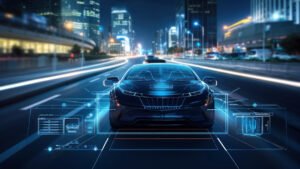Today, cars have more infotainment options than just radios and CD players. These systems combine entertainment and information functions and have become an essential part of driving, offering everything from navigation to music streaming and connectivity to your smartphone. As technology advances, so do car infotainment systems. They now have even more features designed to make things easier, safer, and more fun for drivers and riders.
1. Early Development of Drive-In Theaters
The early days of car entertainment were centered around simple sound systems. By the mid-20th century, AM and FM radios were common in cars, allowing drivers to listen to music and news while driving. Technology continued to advance with the advent of 8-track players, cassette decks, and eventually CD players, allowing drivers to enjoy a wider range of music. However, these early systems could only play music and lacked the attractive features of modern infotainment systems.
2. Get Started with Digital Displays
Digital displays began to be installed in cars in the late 1990s and early 2000s, ushering in a new era of in-car entertainment systems. Initially, these displays were used to display basic information such as time, temperature, and radio stations. Over time, they improved by adding GPS navigation, climate control settings, and vehicle diagnostics. These early digital systems made it possible for touchscreens and connected entertainment systems to become standard on most new cars.
3. Purpose of GPS Navigation
The addition of GPS navigation systems to cars is one of the most significant changes in in-car entertainment. Up until this point, cars had to use paper maps or separate GPS devices to find their way. Adding GPS to infotainment systems has changed the way people drive by displaying route guidance, real-time traffic updates, and points of interest on the display. GPS not only makes driving easier, but it also makes driving safer because drivers don’t have to fiddle with maps or other devices while driving.
4. Add Bluetooth and Smartphones
When Bluetooth came out, everything changed for car entertainment systems. Drivers can use Bluetooth to connect their phones to the car’s system. This allows them to make calls, play music, and check contacts and text messages without taking their hands off the wheel. This feature makes it easier and safer for drivers because they can stay connected while focusing on the road.
As smartphones become more important in everyday life, they are becoming more deeply integrated into car entertainment systems. Apple CarPlay and Android Auto were created so that smartphones and car consoles can communicate seamlessly with each other. These systems allow drivers to use their car’s touchscreen to access mobile applications such as messaging apps, music streaming services, and coaching tools. This makes driving more connected and personal.
5. How Touchscreens Became Popular
In recent years, touchscreens have become the most common way to use entertainment devices in the automotive industry. With these large, high-resolution displays, drivers can switch between the car’s entertainment, guidance, and settings with just a few taps. Touchscreens make infotainment systems easier to understand and use because they work similarly to the smartphones that most users are already used to.
In addition, touchscreen systems give you more freedom in how you look and work. For example, some cars now have multiple screens. The main touchscreen controls navigation and media, while a second screen displays detailed information about the car’s or climate control settings. With this much customization, drivers can more easily get the information they need without distraction.
6. Connect and Update Wirelessly
Over-the-air (OTA) updates add new capabilities to car infotainment systems, and these systems are becoming increasingly connected. Hyundai cars can now receive software updates online just like smartphones. This allows manufacturers to fix bugs, make cars run better, and add new features without having to take the car to a dealership. This connectivity allows new services such as real-time traffic updates, weather forecasts, and streaming services to be added directly to the infotainment system.
Over-the-air (OTA) updates add new capabilities to in-car infotainment systems, and these systems are becoming increasingly connected. Hyundai cars can now receive software updates online, just like smartphones. This allows manufacturers to fix bugs, make cars drive better, and add new features without having to take the car to a dealer. This connectivity also allows new services like real-time traffic updates, weather forecasts, and streaming services to be added directly to the infotainment system.
7. Add more Advanced Safety Features
Information and entertainment systems aren’t just for entertainment and relaxation; they’re also important for improving the safety of your car. Advanced driver assistance systems (ADAS) are built into modern infotainment systems, sending real-time safety alerts and warnings. Many infotainment systems now provide real-time feedback from rear-view mirrors and surround-view cameras, helping drivers navigate tight spaces and avoid accidents.
The infotainment system can also send lane departure warnings, forward collision warnings, and blind spot monitoring to reduce the chance of an accident. Some systems can even automatically apply the brakes in an emergency if they sense an impending accident. Infotainment systems incorporate these safety measures to make the car safer for both the driver and passengers.
8. Infotainment Systems and Autonomous Driving
It is believed that as cars become more autonomous, infotainment systems will become even more important to the driving experience. When cars are fully autonomous, drivers will no longer have to focus on the road. Instead, infotainment systems will become the primary way people communicate with each other and enjoy their journeys. Future infotainment systems could offer immersive entertainment options, such as virtual reality, video conferencing, or even work-from-home tools.
For self-driving cars, the infotainment system could report what’s happening around the car in real-time, informing passengers about routes, traffic, and points of interest along the way. As cars become more autonomous, entertainment systems will evolve from a useful add-on to an important part of the in-car experience.
9. The Future of Infotainment Systems
In the future, infotainment systems in cars will continue to improve. As technology continues to advance, these systems will become more connected, intelligent, and flexible. New technologies such as augmented reality (AR) displays, 5G connectivity, and personalized recommendations based on artificial intelligence will make infotainment systems even better, giving drivers and passengers new ways to interact with the car.
In the coming years, infotainment systems may have better ways to connect to smart home devices, faster access to updates via 5G networks, and more advanced safety features that can predict and prevent collisions before they happen. These improvements will not only make driving more fun but also make driving safer and result in better fuel economy.
Conclusion
Infotainment systems in modern cars have come a long way. Once simple speakers, they are now complex, connected platforms with a wealth of functionality. These systems are now an essential part of driving. They include voice assistants, touchscreen controls, enhanced security systems, and artificial intelligence integration. As technology advances, in-car entertainment systems will become increasingly important, making driving safer, easier, and more enjoyable for everyone.




Comments
The articles you write help me a lot and I like the topic
How can I find out more about it?
Thank you for sharing this article with me. It helped me a lot and I love it.
Good blogs thanks